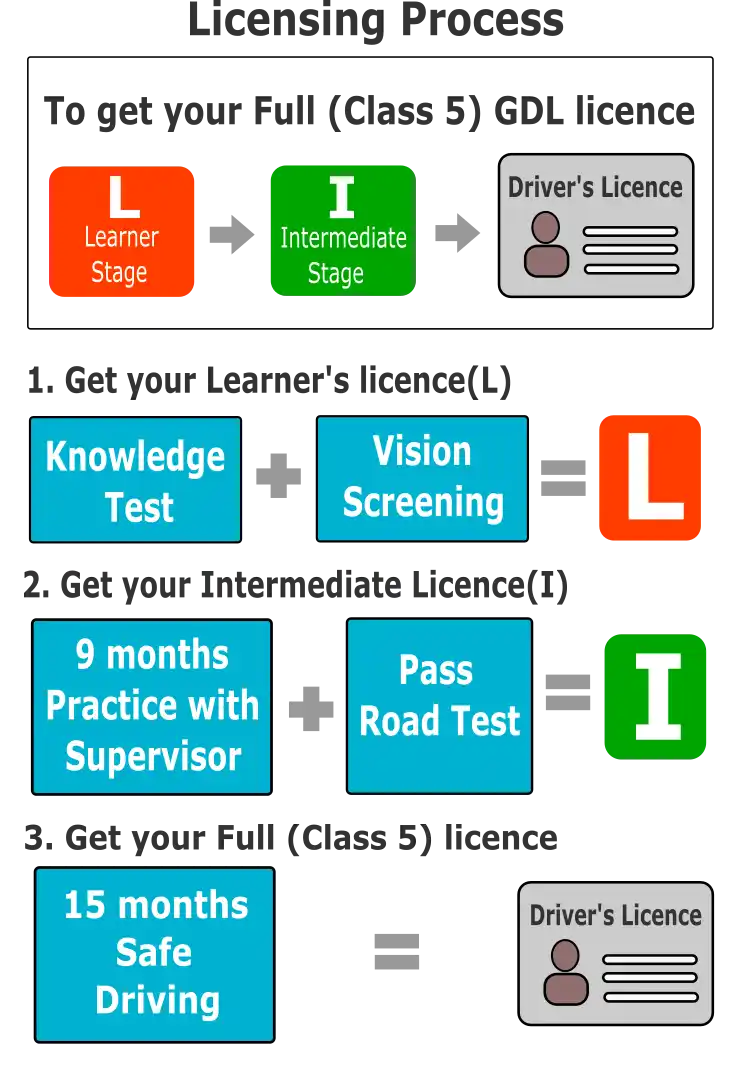Eligibility and Learner’s Permit
Teenagers: If you’re a teenager (aged 16 or 17), you can apply for a learner’s permit. To do so:
- Visit an ICBC driver licensing office.
- Provide proof of identity (e.g., birth certificate, passport).
- Obtain parental consent if you’re under 19.
- Pass the knowledge test, which covers road rules, signs, and safe driving practices.
- The learner’s permit allows you to practice driving under supervision.
Adults: Adults (18 years and older) follow a similar process:
- Apply for a learner’s permit by passing the written test.
- Study the Learn to Drive Smart guide provided by ICBC.
- The learner’s permit allows you to practice driving under supervision.
Senior Learners: Seniors (65 years and older) can also obtain a learner’s permit:
- Follow the same steps as other learners.
- The learner’s permit allows you to practice driving under supervision.
Prepare for the Test
Study Materials:
- Our mobile app should be your primary resource.
- Review road signs, right-of-way rules, and safe driving techniques.
- Take advantage of online practice quizzes and sample tests.
Knowledge Test:
- Visit an ICBC office to take the written knowledge test.
- Answer multiple-choice questions related to road rules, signs, and safety.
- Passing the test grants you a learner’s licence.
Receive Your Learner’s licence
Supervised Driving:
- With the learner’s licence, you can practice driving under supervision.
- Drive with a licensed adult (usually a parent or guardian) who has held a valid licence for at least 2 years.
- Follow any restrictions (e.g., no driving between midnight and 5 a.m.).
Accumulate Driving Experience
Practice Period:
- During the 12-month practice period, accumulate driving experience.
- Practice various maneuvers:
- Parking: Parallel parking, angle parking.
- Lane Changes: Signal properly, check blind spots.
- Turns: Left turns, right turns.
- Drive in different conditions (daytime, nighttime, varying weather) to build confidence.
Apply for the Novice licence (N)
Transition to Novice licence:
- After 12 months of practice, apply for the novice licence (N).
- The novice licence allows you to drive independently with some restrictions:
- Passenger Limit: You can carry only one passenger (unless accompanied by a supervisor aged 25 or older).
- Zero Blood Alcohol Content (BAC): No alcohol allowed while driving.
- Nighttime Restrictions: No driving between midnight and 5 a.m. (unless accompanied by a supervisor).
Full Driver’s licence
Full licence:
- After holding the novice licence for 24 months without any violations, you can apply for a full driver’s licence.
- The full licence removes the restrictions, allowing you to drive independently.
Responsibilities of Licensed Drivers
Privilege and Responsibility:
- Privilege: Holding a driver’s licence is a privilege granted by the authorities. It allows you to operate a motor vehicle legally on public roads.
- Responsibility: Along with this privilege comes a significant responsibility. As a licensed driver, you are accountable for your actions on the road, not only for your safety but also for the safety of others.
Obey Traffic Laws:
- Traffic Signals and Signs: Adhere to traffic signals (red, yellow, green lights) and road signs (stop signs, yield signs, speed limits). These rules ensure orderly and safe traffic flow.
- Right-of-Way: Understand and follow right-of-way rules at intersections, pedestrian crossings, and when merging onto highways.
- Speed Limits: Respect posted speed limits based on road conditions (e.g., residential areas, highways, school zones).
Drive Courteously:
- Patience: Be patient with other drivers. Traffic congestion, unexpected delays, and challenging situations are common. Avoid aggressive behavior or impatience.
- Courtesy: Practice courteous driving. Use turn signals, allow merging vehicles, and yield when necessary. A small act of kindness can prevent road rage and improve overall road safety.
Respect Other Road Users:
- Pedestrians: Always yield to pedestrians at crosswalks. Be cautious near schools, parks, and busy pedestrian areas.
- Cyclists: Give cyclists enough space when passing. Treat them as fellow road users with equal rights.
- Other Vehicles: Maintain safe following distances. Avoid tailgating, sudden lane changes, and aggressive maneuvers.
Safe Driving Habits:
- Avoid Distractions:
- Put away your phone while driving. Distracted driving is a leading cause of accidents.
- Adjust controls (radio, air conditioning) before starting your journey to minimize distractions.
- Defensive Driving:
- Anticipate hazards: Watch for sudden stops, merging vehicles, and pedestrians.
- Keep a safe following distance to allow for reaction time.
- Be aware of blind spots and check mirrors frequently.
Continuous Learning:
- Stay Informed:
- Regularly review the Learn to Drive Smart guide provided by ICBC.
- Be aware of any updates or changes in road rules, safety practices, and traffic laws.
- Attend Defensive Driving Courses:
- Consider taking defensive driving courses. These courses enhance your skills, teach emergency handling techniques, and reinforce safe driving habits.
- Lifelong learning ensures you remain a responsible and informed driver.
